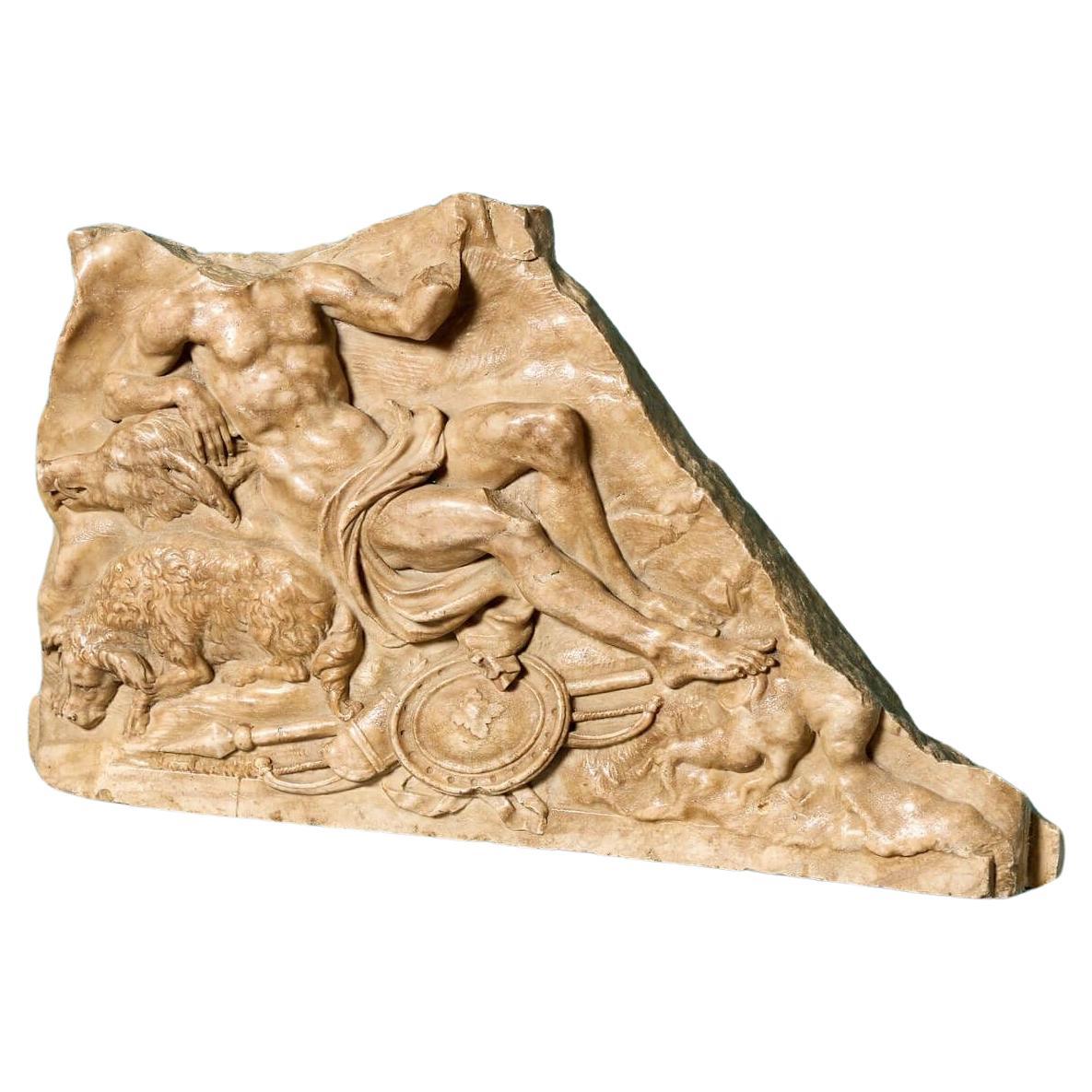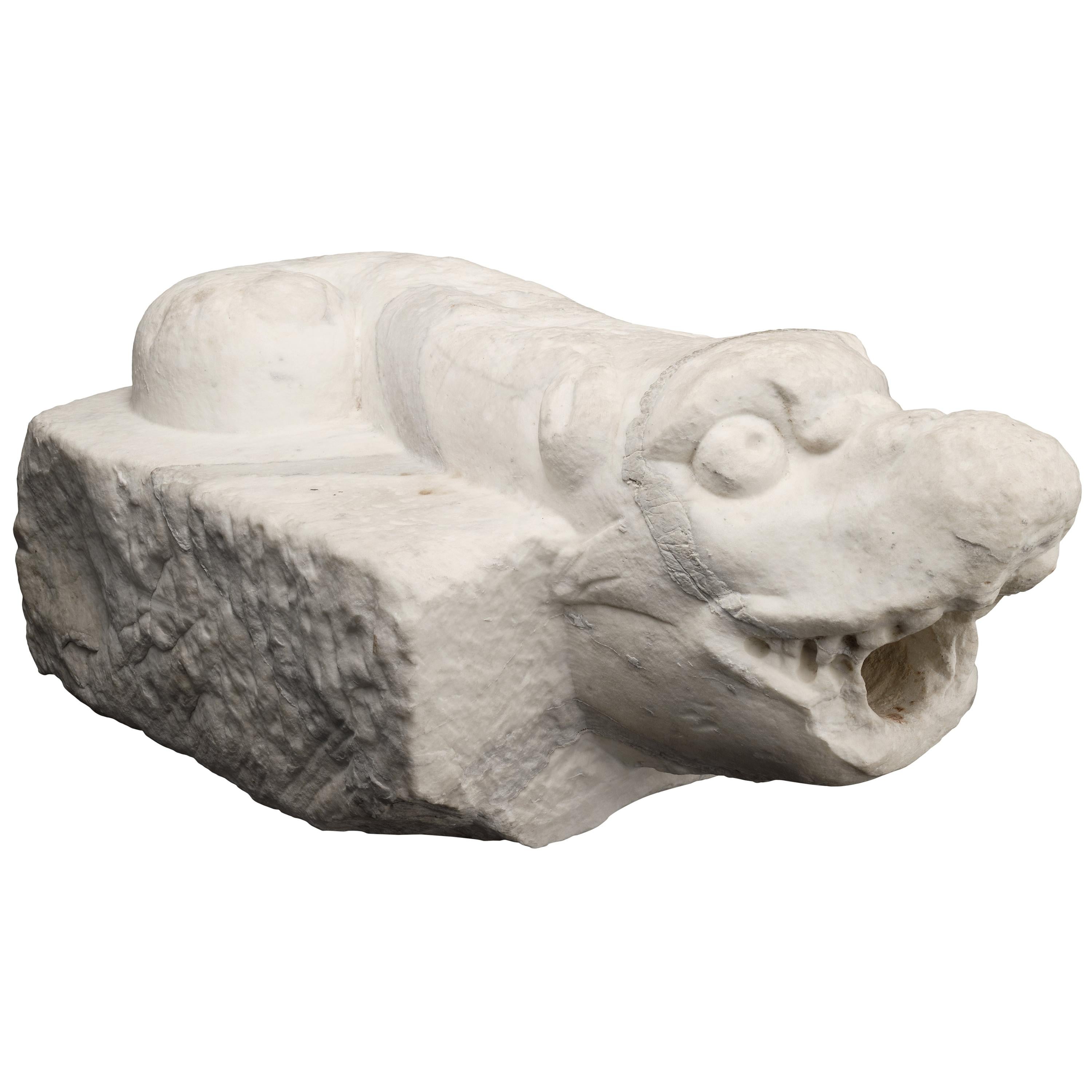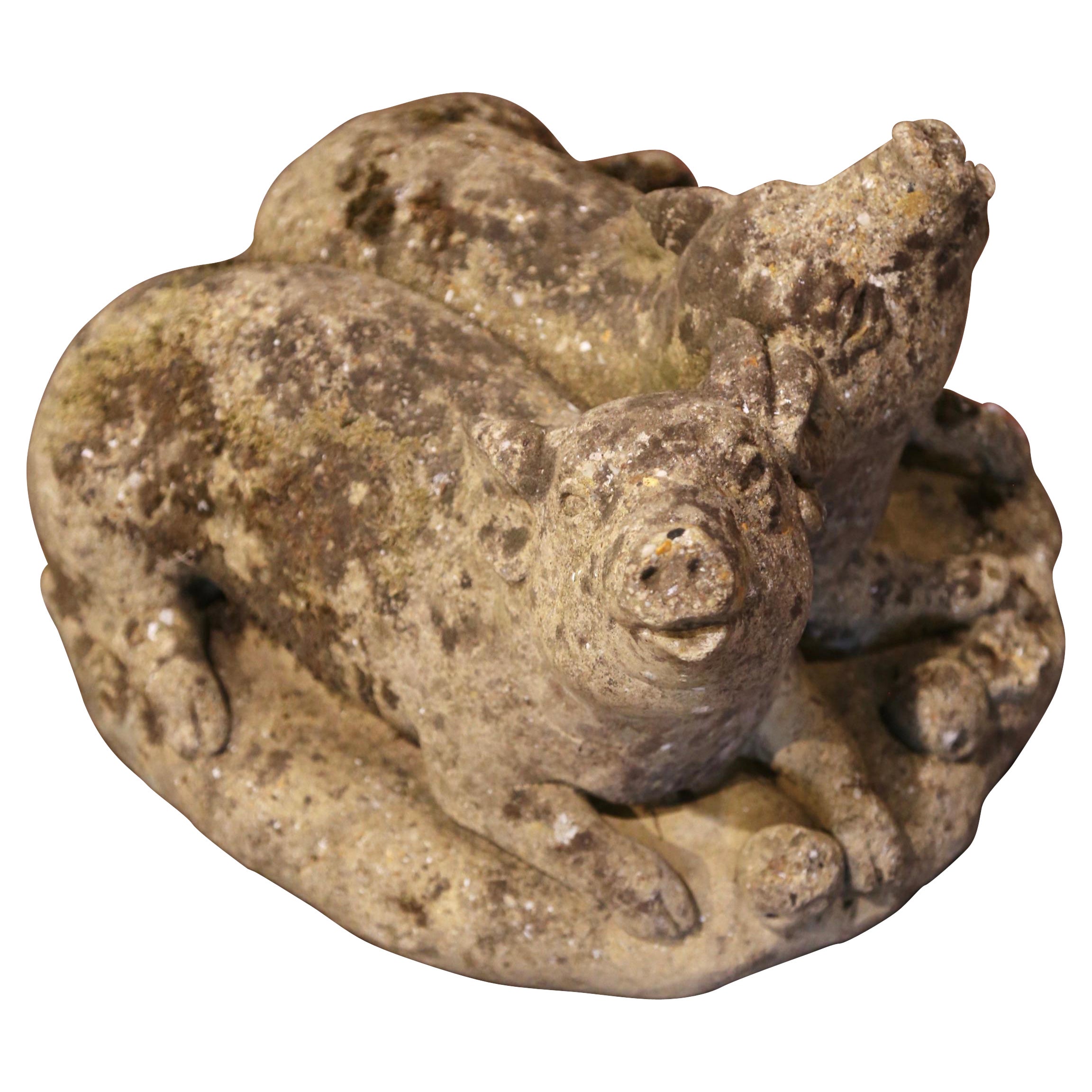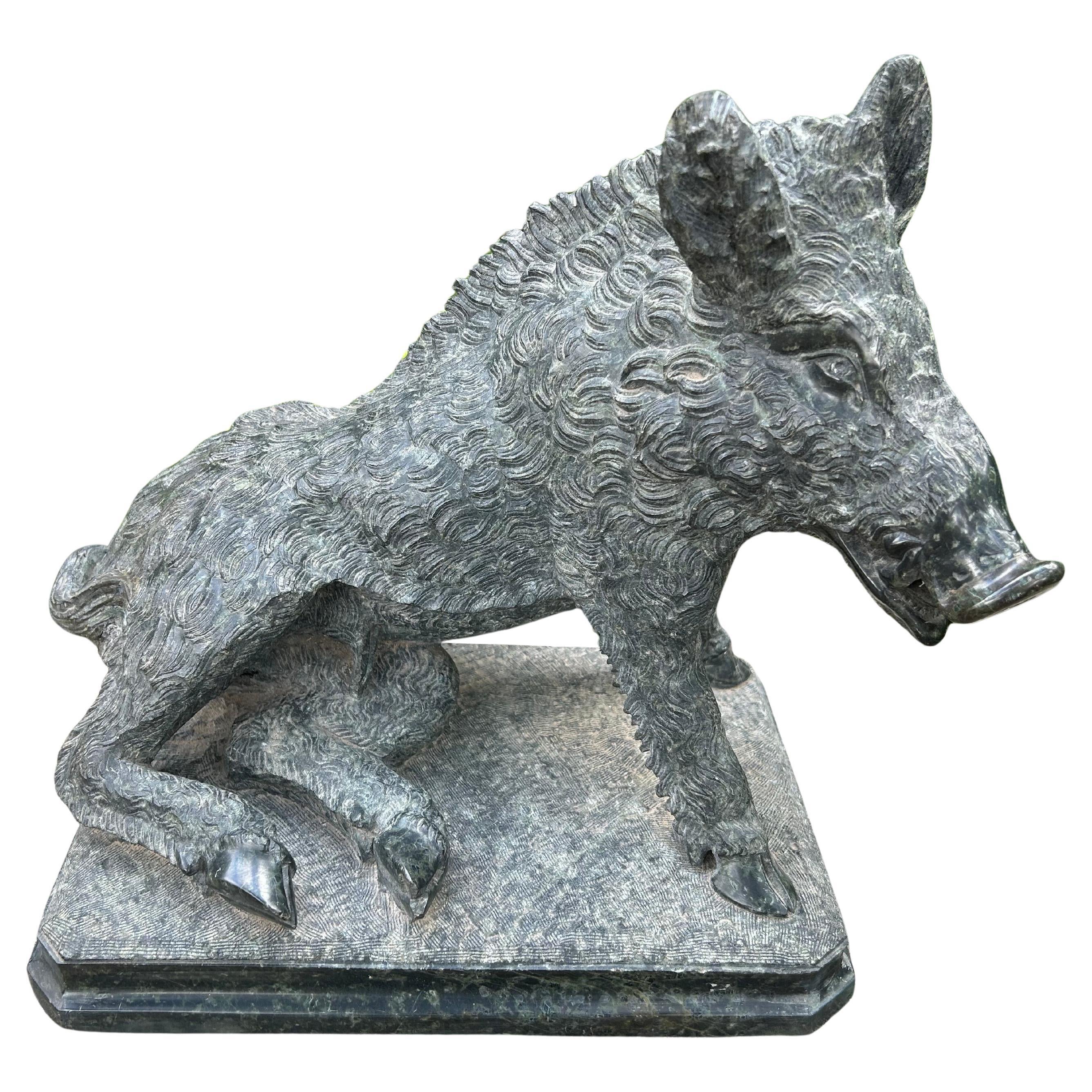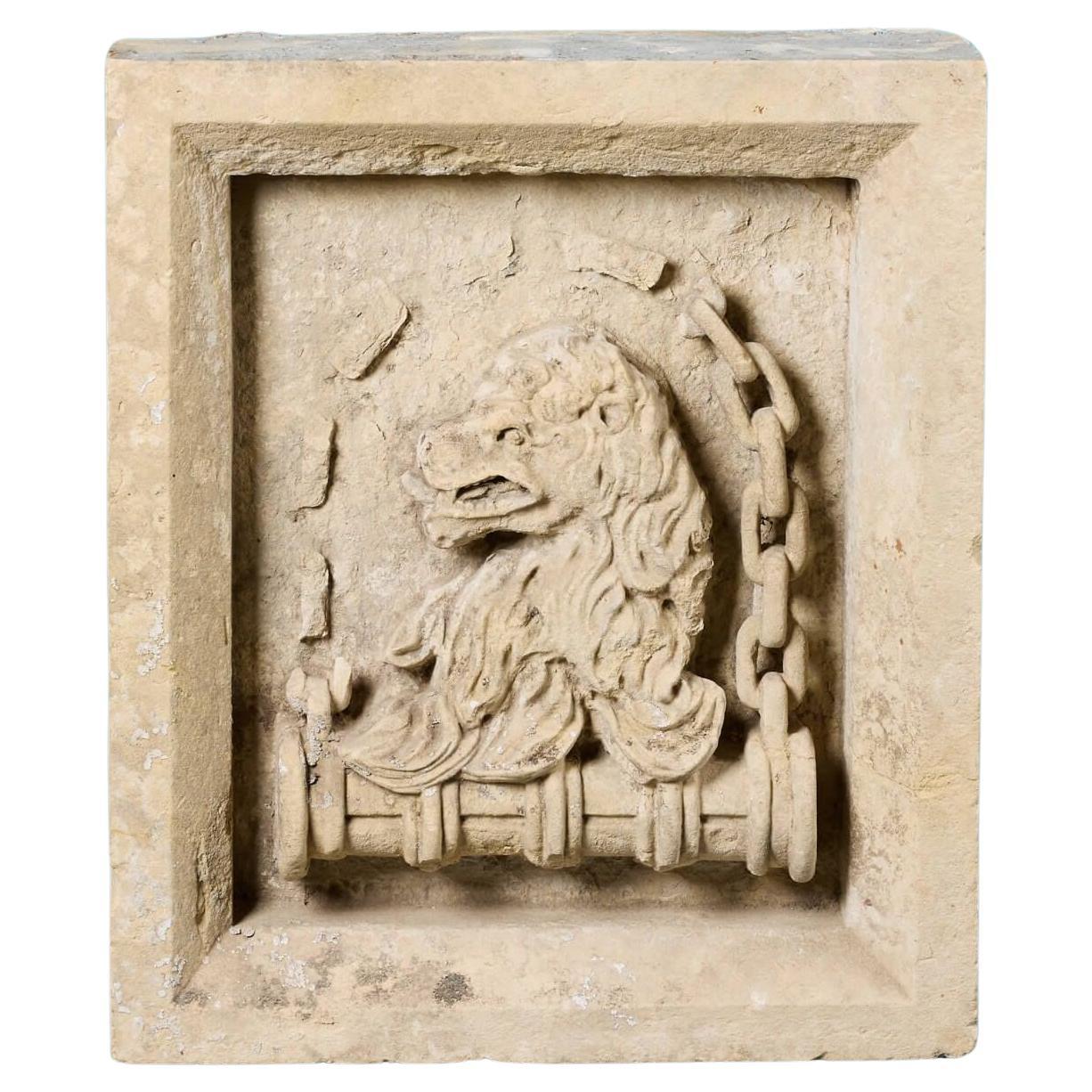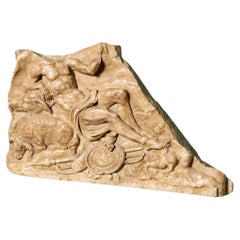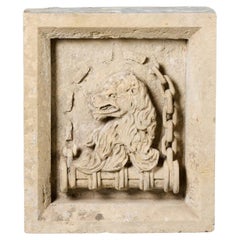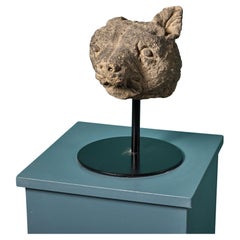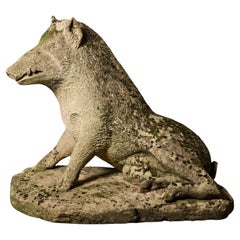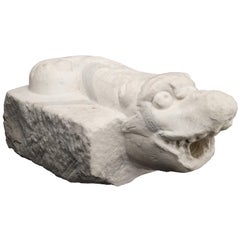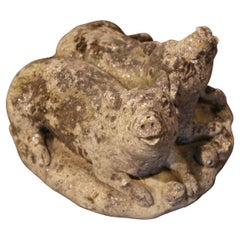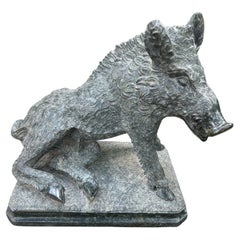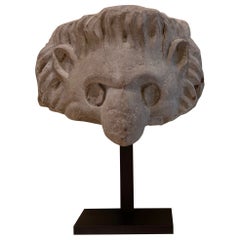Items Similar to 17th Century Marble Boars Head Sculpture
Want more images or videos?
Request additional images or videos from the seller
1 of 6
17th Century Marble Boars Head Sculpture
$3,217.79
£2,375
€2,778.99
CA$4,432.71
A$4,964.36
CHF 2,590.32
MX$60,637.49
NOK 32,956.41
SEK 31,065.37
DKK 20,739.25
About the Item
A carved architectural marble fragment depicting a boars head, reclaimed from Pentney Abbey, Norfolk.
Dating to circa 1680, this freestanding animal sculpture displays a striking stylised design that has certainly stood the test of time. The detailed boar sits proudly to the centre, showcasing its snarling teeth and long snout; the beasts features are certainly eye-catching, leaving room for imagination.
Preserved through time for more than 240 years, today this decorative handcarved sculpture is a fragment of architectural Italian history ready to be take pride of place as an impressive interior piece.
- Dimensions:Height: 12.6 in (32 cm)Width: 10.04 in (25.5 cm)Depth: 3.55 in (9 cm)
- Style:Neoclassical (In the Style Of)
- Materials and Techniques:
- Place of Origin:
- Period:Late 17th Century
- Date of Manufacture:1680
- Condition:Good structural condition. Weathered. Surface chips, wear and losses. Freestanding object with a felt base.
- Seller Location:Wormelow, GB
- Reference Number:Seller: 368191stDibs: LU2096345110452
About the Seller
4.9
Platinum Seller
Premium sellers with a 4.7+ rating and 24-hour response times
Established in 2006
1stDibs seller since 2016
700 sales on 1stDibs
Typical response time: 10 hours
- ShippingRetrieving quote...Shipping from: Wormelow, United Kingdom
- Return Policy
Authenticity Guarantee
In the unlikely event there’s an issue with an item’s authenticity, contact us within 1 year for a full refund. DetailsMoney-Back Guarantee
If your item is not as described, is damaged in transit, or does not arrive, contact us within 7 days for a full refund. Details24-Hour Cancellation
You have a 24-hour grace period in which to reconsider your purchase, with no questions asked.Vetted Professional Sellers
Our world-class sellers must adhere to strict standards for service and quality, maintaining the integrity of our listings.Price-Match Guarantee
If you find that a seller listed the same item for a lower price elsewhere, we’ll match it.Trusted Global Delivery
Our best-in-class carrier network provides specialized shipping options worldwide, including custom delivery.More From This Seller
View All'The Calydonian Boar' 15th Century Italian Marble Fragment
Located in Wormelow, Herefordshire
A large antique Italian marble fragment depicting a section of the Calydonian Boar Hunt. Likely once forming part of a great carved frieze, this marble fragment is thought to be 600 ...
Category
Antique 15th Century and Earlier Italian Renaissance Sculptures and Carv...
Materials
Marble
Antique Limestone Lion Crest or Plaque
Located in Wormelow, Herefordshire
Dating from the 1850s, this carved limestone antique plaque depicts the head of a lion within hand carved chain links, some of which have been lost through the ages. It is more than 170 years old and likely once formed part of a larger piece together with this matching plaque. Perhaps it was once part of a keystone above an entranceway or a family crest wall decoration in the prestigious courtyard of a large estate. Made from fine grained limestone, it has a weathered finish that only time can create and yet the lion plaque...
Category
Antique Mid-19th Century English Georgian Abstract Sculptures
Materials
Stone, Limestone
Antique Carved Stone Bear Head Sculpture
Located in Wormelow, Herefordshire
An antique carved sandstone head of a bear, mounted to a custom steel display stand. This sculpture is thought to have been part of a corbel in a grand ...
Category
Antique Early 17th Century English Georgian Animal Sculptures
Materials
Sandstone, Stone
Antique Limestone Statue of The Uffizi Boar
Located in Wormelow, Herefordshire
After the antique, a finely modelled and weathered limestone garden ornament.
This classical sculpture is generally thought to be based on the story of the slaying of the Calydoni...
Category
20th Century English Grand Tour Statues
Materials
Limestone
Antique Italian Serpentine Sculpture after the Uffizi Boar
Located in Wormelow, Herefordshire
An antique Italian carved serpentine sculpture after the Uffizi boar dating to the early 19th century.
This seated wild boar displays impressive carved details and a pleasing scale ...
Category
Antique Early 19th Century Italian Grand Tour Animal Sculptures
Materials
Serpentine
Carved Stone Dog Head Gargoyle Statue
Located in Wormelow, Herefordshire
A stylised dog gargoyle statue expressively carved into York stone. Dating from the late 19th / early 20th centuries, this dog head is over 100 years old and as such has a naturally ...
Category
Early 20th Century Abstract Sculptures
Materials
Stone
You May Also Like
Italian Ancient Marble Sculpture Fountain, Late 16th Century
Located in Milano, IT
Sea monster
Carrara marble mouth fountain
Italy, late 16th century
It measures 13.8 x 31.5 x 18.9 in (35 x 80 x 48 cm)
State of conservation: some small evident gaps and widespread signs of wear due to outdoor exposure. The gray marks crossing it do not come from restoration, but are rather the natural veins of the marble.
This work has some morphological characteristics typically associated with the iconography of the sea monster: an elongated muzzle, sharp teeth, protruding eyes, elongated ears, and a coiled serpent's tail.
An in-depth series of studies on artistic depictions of the sea monster attempted to verify how this symbol evolved in antiquity in the European and Mediterranean contexts and how it gradually changed its image and function over time. The iconography itself is mutable and imaginative and its history is rich with cultural and artistic exchange, as well as the overlapping of ideas. This occurred so much that it is difficult to accurately pinpoint the "types" that satisfactorily represent its various developments.
However, we can try to summarize the main figures, starting from the biblical Leviathan and the marine creature that swallowed Jonah (in the Christian version, this figure was to become a whale or a "big fish", the “ketos mega”, translation of the Hebrew “dag gadol”). Other specimens ranged from the dragons mentioned in the Iliad (which were winged and had legs) to "ketos” (also from Greek mythology), the terrifying being from whose Latinized name (“cetus”) derives the word "cetacean". See J. Boardman, “Very Like a Whale” - Classical Sea Monsters, in Monsters and Demons in the Ancient and Medieval Worlds, in Papers presented in Honor of Edith Porada, Mainz am Rhein 1987, pp. 73-84).
In Italy the monster underwent yet further variations: it can be found in Etruscan art on the front of some sarcophagi representing the companion of souls, while among the Romans we find the “Pistrice” (cited by Plinio in Naturalis Historia PLIN., Nat., II 9, 8 and by Virgilio in Eneide: VERG., Aen., III, 427), which appeared in the shape of a stylized hippocampus or a very large monstrous cetacean and evolved into a hideous being with a dragon's head and long webbed fins.
During the Middle Ages, the sea monster was the object of new transformations: at this time, it is often winged, the head is stretched like a crocodile, the front legs are often very sharp fins - sometimes real paws - until the image merges with dragons, the typical figures of medieval visionary spirituality widely found throughout Europe (on this topic and much more, see: Baltrušaitis, J., Il Medioevo fantastico. Antichità ed esotismi nell’arte gotica, Gli Adelphi 1997).
In Italy during the 15th and 16th centuries, the revival of classicism - representative of the humanistic and Renaissance periods - led to a different reading of these "creatures". Indeed, the sea monster was also to find widespread use as an isolated decorative motif, especially in numerous fountains and sculptures where dolphins or sea monsters were used as a characterizing element linked to water (on this theme see: Chet Van Duzer, Sea Monsters on Medieval and Renaissance Maps, London, The British library, 2013).
From the morphological point of view, the "sea monsters" of this period are mostly depicted as hybrid figures, in which the body of a mythological or real being (a hippocampus, a sea snake, a dolphin), is joined to a head with a rather indistinct appearance. It was usually characterized by large upright ears, an elongated snout, sharp teeth and globular, protruding eyes; a complex and indefinite figure, both from the symbolic point of view and from that of its genesis.
The work we are examining is placed as a cross between the medieval sea serpent and the Renaissance dolphin, with stylistic features which recall the snake as often used in heraldry (such as the "snake" depicted in the coat of arms of the Visconti - the lords and then dukes of Milan between 1277 and 1447 - and which, for some, may be derived from the representations of the “Pistrice” that swallowed Jonah).
In the search for sources, Renaissance cartography and in particular woodcuts should not be neglected. See for example the monsters of Olaus Magnus, from the editions of the “Historia de gentibus septentrionalibus” (“History of the peoples of the north”) and the natural histories of Conrad Gesner, Ulisse...
Category
Antique 16th Century Italian Renaissance Animal Sculptures
Materials
Carrara Marble
19th Century French Weathered Concrete Garden Pig Composition Sculpture
Located in Dallas, TX
Decorate a patio with this antique pig sculpture composition. Crafted in France circa 1880 and carved of concrete, the sculpture features two pigs resting ...
Category
Antique Late 19th Century French Animal Sculptures
Materials
Concrete
Italian Carved Marble Boar Sculpture
Located in Houston, TX
Italian Carved Marble Boar Sculpture.
We offer a well carved copy of the original Italian marble boar sculpture located in Florence Italy. This version...
Category
Vintage 1920s Italian Classical Roman Animal Sculptures
Materials
Marble
16h century Griffin Head - Italy
Located in Bruxelles, BE
Griffin head
Italy, 16th century
On a modern metal stand
Measures: 20 x 29 x 21 cm (without the stand)
The griffin is a legendary creature with the body of a lion, the head an...
Category
Antique 16th Century Italian Renaissance Animal Sculptures
Materials
Marble
18th–19th Century Spanish Carved Stone Lion’s Head Wall Element
Located in Bonita Springs, FL
18th–19th Century Spanish Carved Stone Lion’s Head Wall Element
A powerful and expressive sculptural fragment depicting a lion’s head, originally part of a grand architectural ensemb...
Category
Antique 19th Century Spanish Neoclassical Figurative Sculptures
Materials
Stone, Metal
19th Century Italian Carrara Marble Horse Head - Antique Décor Sculpture
Located in West Palm Beach, FL
A late 19th Century, antique Italian horse head sculpture with harness and mane in a classic style. This statuette was carved by hand in Carrara Marble. It has its’ original antique ...
Category
Antique Late 19th Century Italian Animal Sculptures
Materials
Limestone, Carrara Marble
